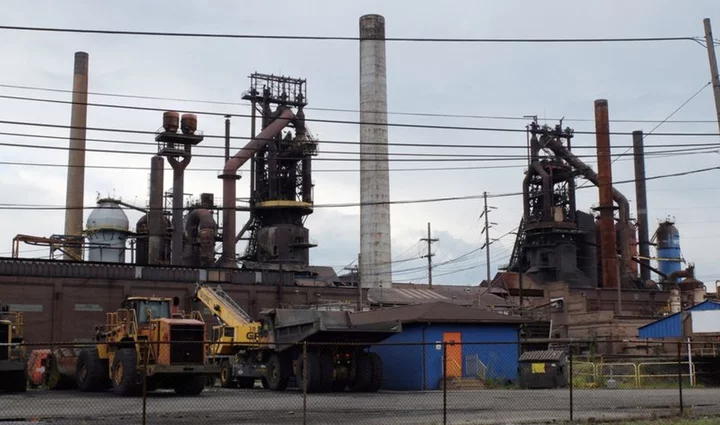By Anirban Sen and David Carnevali
NEW YORK U.S. Steel Corp attracted acquisition interest after short-term challenges, including upgrading furnaces and potential car production shutdowns, weighed on its valuation, according to people familiar with the deliberations of its suitors.
The Pittsburgh-based company, which has a market value of $6.8 billion, is exploring its options amid acquisition offers from other industry players, including Cleveland-Cliffs Inc and Esmark Inc. Reuters reported on Wednesday that ArcelorMittal SA was also studying a potential bid.
Prior to disclosing the takeover interest on Aug. 13, U.S. Steel's shares were undervalued compared to many of its major peers. The company's market value, including net debt, was equivalent to 3.6 times its projected 12-month earnings before interest, taxes, depreciation and amortization (EBITDA), compared to 5 times for Cleveland Cliffs.
Two other U.S. rivals, Nucor Corp and Steel Dynamics Inc, trade at 6.9 times and 5.8 times, respectively, according to Refinitiv data.
This discount, combined with a desire to grow market share and realize cost synergies, pushed Cleveland-Cliffs to approach U.S. Steel with an offer last month, and Esmark to follow suit, the sources said. These two companies' offers both value U.S. steel at 6.2 times its 2024 EBITDA, according to RBC Capital Markets analysts.
Some of the valuation discount is likely temporary and partly the result of U.S. Steel's current capital expenditure, the sources and analysts who cover the company said.
U.S. Steel has said it will spend about $2.5 billion in 2023 - about as much it posted in net earnings in 2022 - on its equipment, including replacing some of its old blast furnaces to electric arc furnaces (EAFs).
Unlike blast furnaces, EAFs do not have to be operated at constant rates, allowing them to adjust to fluctuations in steel demand. EAFs also release much less carbon dioxide than blast furnaces, reducing climate-warming emissions.
While the investment in equipment is expected to pay off long term, it has limited how much capital U.S. Steel can return to shareholders in the near term, which has been another company priority. The company has completed $1.2 billion in share buybacks in the last two years.
Also weighing on U.S. Steel are concerns about potential strikes in the auto sector, a major client. U.S. President Joe Biden called for union auto workers and Detroit's Big Three automakers this week to avert strikes with a new agreement, before their contracts expire next month.
The automotive and transportation sector represented almost a quarter of steel shipments out of U.S. Steel's North American facilities in 2022, according to the company's annual report. Cleveland-Cliffs has a similar exposure.
"U.S. auto industry strikes would impact Cliffs and U.S. Steel, as blast furnace operators, more than EAF players, hence this may have been just the opportunity for Cliffs to lob a bid for U.S. Steel," Jefferies analysts wrote in an Aug. 14 note.
MANUFACTURING RENAISSANCE
There is, however, upside in U.S. Steel that Cleveland-Cliffs and other suitors have spotted, according to the sources.
The company provides steel for renewable energy infrastructure, such as wind turbines, and so stands to benefit from the Inflation Reduction Act (IRA), which provides tax credits and other incentives for such projects, and also comes with 'buy American' provisions. U.S. Steel CEO David Burritt has praised the IRA as a major boon, calling it the "Manufacturing Renaissance Act".
The company also expects its investment in the production of electrical steel, used in applications such as electric vehicle motors and power transformers, to pay off. It forecasts a 7% compound annual growth rate just in non-grain oriented electrical steel and in motor laminate, compared with 1% for the broader steel sheet market.
The U.S. steel industry has already benefited from import tariffs imposed in 2018 under former President Donald Trump. Supply chain disruptions and rising inflation, however, have since weighed on both U.S. Steel and its peers.
(Reporting by Anirban Sen and David Carnevali in New York; Editing by Greg Roumeliotis and Sonali Paul)









